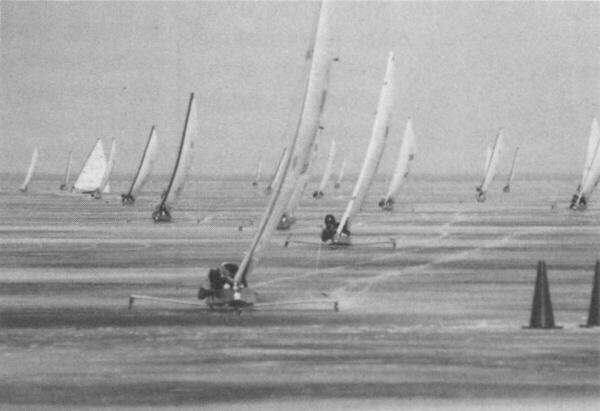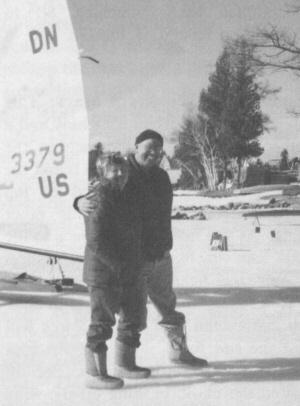The Basics = Sailing Smartby Jane Pegel - US 803 The experienced sailor has developed skills that enable him to have a great day of sailing and racing in a variety of conditions. This sailor (I am avoiding using "he") has the ability to select an appropriate ice site, appropriate ice site, properly rig the boat for the conditions of the day, and then properly handle the boat under sail. Past newsletter articles have addressed ice conditions, others have addressed tuning, but few have addressed the basic principles involved in becoming a good iceboater. Good iceboaters sail smart. My goal here is to discuss some of the factors to be considered if you want to sail smart. One would think that just plain common sense would cause a sailor to sail his boat in a manner appropriate for the conditions. But my mother was correct when she used to say, "People can find more ways to try to kill themselves." In Parking Areas Hardly a day on the ice goes by that I do not see someone looking for trouble. First of all, don't bring your pre-school age child down to the ice without a crash helmet on his head. A toddler has difficulty walking on bare ground, don't put him on slippery ice. Likewise with your family dog. A child old enough to use ice skates should be brain washed about being around iceboats. He should understand that the iceboat cannot stop quickly. Designate a safe area for skating and stress the importance of his staying in that area. And I'm not pleased when an ice-skate creases the side of my boat when its wearer crashes and bums. Whenever your boat is left unattended, be sure she is parked into the wind and the parking brake is on. It is also a good idea to pull the mainsheet line out of the aft blocks in case the wind shifts. DN rules require use of the parking brake. Care must be taken when maneuvering in a crowded parking area. Whatever you do, DO IT SLOWLY. Pushing or pulling the boat should only be done in a direction straight into the wind. If you must head across or down wind, GET INTO THE BOAT so you have maximum control and visibility. Don't ride on the runner plank, sitting or standing. If a pedestrian, skater, or boat unexpectedly crosses your path, your maneuverability is limited when you're tiding on the runner plank. Don't park your boat in a high traffic area. As provided in the racing rules, a good race committee will establish a safety zone down wind of the finish line. This provides for a clear "sail out" zone after boats cross the finish line. Boats and gear parked in the safety zone may be disqualified. Finally, when there is a good breeze blowing, hoist your sail after you have pushed the boat clear of a crowded parking area, and lower it prior to returning. Turning and Stopping Rocketing down the ice is the ultimate iceboating thrill. But how do you stop the darn thing? Or how do you turn the race mark when you're approaching it at warp speed? Let's take a look at the boat handling skills involved: Stopping: Almost everyone knows you have to arm into the wind to stop. But not everyone knows the steps in the transition from rocketing to stop. The ultimate stopping challenge is on hard ice with a strong wind. If you're sailing on-the-wind, merely head into the wind and allow enough space for your speed to, "bleed out". If you're sailing off-the-wind at top speed, head straight down wind with your sail trimmed hard, this will allow you to slow down as the wind passes by your sail. The next step will be to turn across the wind (onto a reach) and then into the wind. As you start to turn onto the reach, ease the sail well out so you won't be thrown into a hike. Keep your weight forward in the boat so there is adequate pressure on the steering runner. Quickly turn toward the wind. If you're having trouble getting the boat to turn toward the wind, trimming the main slightly will help pivot the boat into the wind. Then as you get into the wind, trim the sail to reduce the flogging of the sail, battens and boom. As you coast to a stop, resist the temptation to drag your feet on the ice. In a DN it's easy to swing your feet out of the boat, but if your spikes catch a flaw on the ice, you may break your leg. Turning the Leeward Mark: You can apply some of the' techniques described for stopping, but as you get headed on-the-wind after rounding the mark, just trim in and keep going. Because you're likely to be rounding with other boats, it is very important to remember the two key things of trimming the sail is to pivot the boat in the turn and keeping your weight forward to hold the front runner on the ice. The Gold Fleet sailor approaches the leeward mark at high speed, heads for a pivot point about 50 feet from the mark toward the side where the race committee stands. He (this is a generic term) momentarily heads down wind to bleed off some speed, then turns for the mark into a, "transition zone", with the sail eased enough so that the boat does not hike. In this final approach he is headed toward a point about 15 feet down wind of the mark. When he gets about 20 feet from this point, he starts the turn, and as he comes close to the mark he is already headed on-the-wind with the sail trimmed hard. This is the perfect turn. The exact ice and wind conditions and the presence of other boats always require instantaneous adjustments. As the Bronze Fleet sailor comes down to the leeward mark, his initial heading is usually too close to the mark, he has not provided for a "transition zone" and instead of being headed on-the-wind as he passes close to the mark, his boat may be in an uncontrolled hike, careening off to starboard, a hazard to himseft and to others.
Port tack layline? Not likely! Sail smart - think
ahead!! Rounding the Windward Mark: This can be hazardous when it's windy and a number of boats are approaching the mark together. The goal is to round the mark and head off-the-wind at top speed without colliding with other boats. As you make the approach to the mark lean way back with the mainsheet in your right hand and your hand close to your chest. If the boat starts to hike, you can extend your arm and this will case the sail some. Try to keep your body aft to hold the boat down. Peel off around the mark, heading off-the-wind until the boat comes out of the hike. If you're strong enough, you can trim the mainsheet as the boat comes out of the hike. Keep a firm grip on the tiller. Stay in sync with other boats making the turn. When all runners are on the ice and the boat is tracking a straight line, then you might be able to put the tiller between your knees and trim with both hands, but please don't try this when you're sailing close to me. The Right of Way Rules We race under the rules of the National Iceboat Authority. These rules were developed in 1963 by representatives of each of the iceboat class associations. Prior to that time we encountered different rules in different regattas. You can imagine the confusion. The basic philosophy of the rules:
The "inside" exception is the port tack boat approaching the windward mark, who must give way to the starboard tack boat. A sailor who keeps in mind the basic premises will find it easy to make safe and smart moves on the race course.
This article was originally printed in the December 1992 newsletter |
Last modified March 25, 2005

